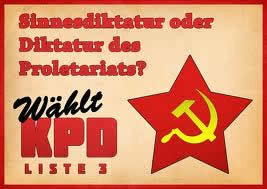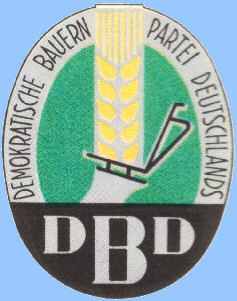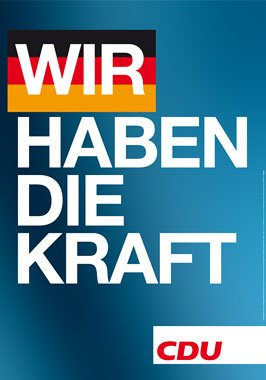Home
Architecture
Art
Beauty/Health
Beer
Business/Economy
Cars
Celebrities
Christmas
Dictionaries
Education
Fashion/Clothes
Food
Galleries
Gays/Lesbians
Genealogy
German Names
Germans Abroad
History
Holidays
Homework Help
Learn German
Law
Literature
Loveparade
Movies
Music
Nazi
News
Oktoberfest
Philosophy
Today in History
Traditions
Travel to Germany
Wines
More topics...
Facts About Germany
Armed Forces
Education
Economy
History
Geography
Mass Media
Politics
Society
German History
Early History
Medieval History
Thirty Years' War
Weimar Republic
Third Reich
Postwar
Honecker Era
Berlin Wall
Bismarck
German Recipes
Salads
Main Dishes
Desserts
Baking
German Chocolate Cake
Easter Dishes
Halloween Dishes
Christmas Dishes
How To in Germany
Articles
Quizzes
|
Political Parties and Democratization
The reintroduction of democratic political parties in Germany was one
of the primary concerns of the Allies during the final phase of the war.
The Soviet authorities were the first to reestablish political parties
in their zone. They ordered the formation of political parties on June
10, 1945, well before such a directive was issued in the Western zones.
In addition to seeking to control their own zone, they hoped to influence
the emerging political constellations in the Western zones by the early
mobilization of a strong leftist movement.
 On June 11, the Communist Party of Germany (Kommunistische Partei Deutschlands--KPD)
was reestablished in the Soviet zone under a German leadership that, for
the most part, had lived for years in Moscow. Wilhelm Pieck was its chairman.
Shortly thereafter, the Social Democratic Party of Germany (Sozialdemokratische
Partei Deutschlands--SPD) was also reconstituted, under the leadership
of Otto Grotewohl. When it became obvious that the SPD would emerge as
the most popular leftist party in the Soviet zone, the Soviet authorities
forced the merger of the KPD and the SPD in April 1946 and subsequently,
from this merger, the formation of the Socialist Unity Party of Germany
(Sozialistische Einheitspartei Deutschlands--SED). The Communists clearly
had the upper hand in SED leadership. Vigorous resistance to the merger
of the two leftist parties came from Social Democrats in the Western zones,
led by Kurt Schumacher, a veteran Social Democratic politician and member
of the Reichstag during the Weimar Republic and a political prisoner during
the Third Reich. As a result of this principled opposition to Communist
control, the rebuilding of the SPD in the Western zones took a separate
course. On June 11, the Communist Party of Germany (Kommunistische Partei Deutschlands--KPD)
was reestablished in the Soviet zone under a German leadership that, for
the most part, had lived for years in Moscow. Wilhelm Pieck was its chairman.
Shortly thereafter, the Social Democratic Party of Germany (Sozialdemokratische
Partei Deutschlands--SPD) was also reconstituted, under the leadership
of Otto Grotewohl. When it became obvious that the SPD would emerge as
the most popular leftist party in the Soviet zone, the Soviet authorities
forced the merger of the KPD and the SPD in April 1946 and subsequently,
from this merger, the formation of the Socialist Unity Party of Germany
(Sozialistische Einheitspartei Deutschlands--SED). The Communists clearly
had the upper hand in SED leadership. Vigorous resistance to the merger
of the two leftist parties came from Social Democrats in the Western zones,
led by Kurt Schumacher, a veteran Social Democratic politician and member
of the Reichstag during the Weimar Republic and a political prisoner during
the Third Reich. As a result of this principled opposition to Communist
control, the rebuilding of the SPD in the Western zones took a separate
course.
 The SED sought to retain the image of a political force open to the masses,
and it governed through the active participation of its members. It also
competed with other parties in regional elections. After the Land
elections of October 1946 in which the SED failed to obtain an absolute
majority, the party resorted to different tactics in order to secure its
grip on the electorate. SED leaders created an Anti-Fascist Bloc consisting
of all political parties that was to guarantee the introduction of an
antifascist and democratic order in the Soviet zone. From the very beginning,
the SED could veto any proposal from any other bloc party not in accordance
with its ideals for a socialist society. As a result, the two other political
parties authorized in the Soviet zone were purged of their leadership,
and their party programs were realigned in support of SED goals. The two
other parties were the Christian Democratic Union (Christlich Demokratische
Union--CDU), which represented middle-class interests, and the Liberal
Democratic Party of Germany (Liberal-Demokratische Partei Deutschlands--LDPD),
which represented the liberal political tradition that dated back to the
late 1840s. The SED sought to retain the image of a political force open to the masses,
and it governed through the active participation of its members. It also
competed with other parties in regional elections. After the Land
elections of October 1946 in which the SED failed to obtain an absolute
majority, the party resorted to different tactics in order to secure its
grip on the electorate. SED leaders created an Anti-Fascist Bloc consisting
of all political parties that was to guarantee the introduction of an
antifascist and democratic order in the Soviet zone. From the very beginning,
the SED could veto any proposal from any other bloc party not in accordance
with its ideals for a socialist society. As a result, the two other political
parties authorized in the Soviet zone were purged of their leadership,
and their party programs were realigned in support of SED goals. The two
other parties were the Christian Democratic Union (Christlich Demokratische
Union--CDU), which represented middle-class interests, and the Liberal
Democratic Party of Germany (Liberal-Demokratische Partei Deutschlands--LDPD),
which represented the liberal political tradition that dated back to the
late 1840s.
 Two additional bloc parties were established in 1948 in the Soviet zone
to represent groups still without a specific political party. The Democratic
Peasants' Party of Germany (Demokratische Bauernpartei Deutschlands--DBD)
was formed to prepare farmers for the planned land reform, which would
involve extensive nationalizations. The second party, the National Democratic
Party of Germany (National-Demokratische Partei Deutschlands--NDPD), was
to work at reintegrating into a socialist society approximately 2 million
people of right-wing views. The group included veterans and a relatively
large number of former members of the National Socialist German Workers'
Party (National-Sozialistiche Deutsche Arbeiterpartei--NSDAP), Adolf Hitler's
party. Two additional bloc parties were established in 1948 in the Soviet zone
to represent groups still without a specific political party. The Democratic
Peasants' Party of Germany (Demokratische Bauernpartei Deutschlands--DBD)
was formed to prepare farmers for the planned land reform, which would
involve extensive nationalizations. The second party, the National Democratic
Party of Germany (National-Demokratische Partei Deutschlands--NDPD), was
to work at reintegrating into a socialist society approximately 2 million
people of right-wing views. The group included veterans and a relatively
large number of former members of the National Socialist German Workers'
Party (National-Sozialistiche Deutsche Arbeiterpartei--NSDAP), Adolf Hitler's
party.
 The Social Democratic Party that operated in the Western zones was, in
contrast to the Eastern SPD, markedly anticommunist. This attitude reflected a continuation of its
bitter hostility to the Communists during the Weimar Republic. The reestablished
party, headed by Kurt Schumacher and, after his death, by Erich Ollenhauer,
could look back on a distinguished history of creating better living conditions
for the working class within the context of parliamentary democracy. Although
anticommunist, the SPD's leadership still regarded the party as Marxist
and remained committed to working for a socialist economy. As such, the
SPD envisioned a neutral socialist Germany located between the capitalist
economies of the West and the Soviet dictatorship of the East. The SPD
was able to build on its extensive working-class membership, which predated
Hitler's seizure of power in 1933. The Social Democratic Party that operated in the Western zones was, in
contrast to the Eastern SPD, markedly anticommunist. This attitude reflected a continuation of its
bitter hostility to the Communists during the Weimar Republic. The reestablished
party, headed by Kurt Schumacher and, after his death, by Erich Ollenhauer,
could look back on a distinguished history of creating better living conditions
for the working class within the context of parliamentary democracy. Although
anticommunist, the SPD's leadership still regarded the party as Marxist
and remained committed to working for a socialist economy. As such, the
SPD envisioned a neutral socialist Germany located between the capitalist
economies of the West and the Soviet dictatorship of the East. The SPD
was able to build on its extensive working-class membership, which predated
Hitler's seizure of power in 1933.
For the conservative forces, the political beginning after 1945 appeared
more difficult because of past fragmentation on regional and denominational
lines. The persecution and suppression suffered during the Third Reich by conservative Catholics and Protestants alike gave rise to a unified
Christian conservative party, which would represent all who opposed communism
and socialism and who held traditional Christian middle-class values.
At first, several regional political organizations formed in Berlin, Cologne,
and Frankfurt am Main.
 On December 16, 1945, it was agreed that their
collective designation should be called the Christian Democratic Union
(Christlich Demokratische Union--CDU). On December 16, 1945, it was agreed that their
collective designation should be called the Christian Democratic Union
(Christlich Demokratische Union--CDU).
During the initial phase of development, members of the Christian labor
unions strongly influenced the program of the conservative movement. Although
they did not dispute the concept of private ownership of property, they
advocated state control for many principal industries. During the 1950s,
a market-oriented policy that was combined with a strong social component
came to dominate the party.
The Bavarian Christian conservative organization, the Christian Social
Union (Christlich-Soziale Union--CSU), founded in October 1946, remained
a separate party organization and kept its name even after the foundation
of the FRG. It followed a more pronounced conservative ideological party
line than the CDU.
Even more difficult than the political unification of Christian conservatives
was the consolidation of the liberal movement in postwar Germany. Traditionally,
the liberals had been divided into a conservative national liberal wing
and a more leftist-oriented liberal movement. There was also a reservoir
of voters who understood themselves to be truly liberal in that they did
not commit themselves to any ideology. Common to all of the party groupings,
however, was the rejection of a planned economy. A number of independent
liberal party groups existed for a time in southwestern Germany and in
Hesse, Hamburg, and Berlin. In November 1948, most of them united in the
Free Democratic Party (Freie Demokratische Partei--FDP), whose main figure,
Theodor Heuss, became the first federal president of the FRG.
- Postwar Occupation and Division
- The Establishment
of Occupation Zones
- The Nuremberg
Trials and Denazification
- Political Parties
and Democratization
- The Creation of the Bizone
- The Birth of the Federal Republic
of Germany
- The Birth of the German Democratic
Republic
Google
|
|



 On June 11, the Communist Party of Germany (Kommunistische Partei Deutschlands--KPD)
was reestablished in the Soviet zone under a German leadership that, for
the most part, had lived for years in Moscow. Wilhelm Pieck was its chairman.
Shortly thereafter, the Social Democratic Party of Germany (
On June 11, the Communist Party of Germany (Kommunistische Partei Deutschlands--KPD)
was reestablished in the Soviet zone under a German leadership that, for
the most part, had lived for years in Moscow. Wilhelm Pieck was its chairman.
Shortly thereafter, the Social Democratic Party of Germany ( The SED sought to retain the image of a political force open to the masses,
and it governed through the active participation of its members. It also
competed with other parties in regional elections. After the Land
elections of October 1946 in which the SED failed to obtain an absolute
majority, the party resorted to different tactics in order to secure its
grip on the electorate. SED leaders created an Anti-Fascist Bloc consisting
of all political parties that was to guarantee the introduction of an
antifascist and democratic order in the Soviet zone. From the very beginning,
the SED could veto any proposal from any other bloc party not in accordance
with its ideals for a socialist society. As a result, the two other political
parties authorized in the Soviet zone were purged of their leadership,
and their party programs were realigned in support of SED goals. The two
other parties were the Christian Democratic Union (
The SED sought to retain the image of a political force open to the masses,
and it governed through the active participation of its members. It also
competed with other parties in regional elections. After the Land
elections of October 1946 in which the SED failed to obtain an absolute
majority, the party resorted to different tactics in order to secure its
grip on the electorate. SED leaders created an Anti-Fascist Bloc consisting
of all political parties that was to guarantee the introduction of an
antifascist and democratic order in the Soviet zone. From the very beginning,
the SED could veto any proposal from any other bloc party not in accordance
with its ideals for a socialist society. As a result, the two other political
parties authorized in the Soviet zone were purged of their leadership,
and their party programs were realigned in support of SED goals. The two
other parties were the Christian Democratic Union ( Two additional bloc parties were established in 1948 in the Soviet zone
to represent groups still without a specific political party. The Democratic
Peasants' Party of Germany (Demokratische Bauernpartei Deutschlands--DBD)
was formed to prepare farmers for the planned land reform, which would
involve extensive nationalizations. The second party, the National Democratic
Party of Germany (National-Demokratische Partei Deutschlands--NDPD), was
to work at reintegrating into a socialist society approximately 2 million
people of right-wing views. The group included veterans and a relatively
large number of former members of the National Socialist German Workers'
Party (National-Sozialistiche Deutsche Arbeiterpartei--NSDAP), Adolf Hitler's
party.
Two additional bloc parties were established in 1948 in the Soviet zone
to represent groups still without a specific political party. The Democratic
Peasants' Party of Germany (Demokratische Bauernpartei Deutschlands--DBD)
was formed to prepare farmers for the planned land reform, which would
involve extensive nationalizations. The second party, the National Democratic
Party of Germany (National-Demokratische Partei Deutschlands--NDPD), was
to work at reintegrating into a socialist society approximately 2 million
people of right-wing views. The group included veterans and a relatively
large number of former members of the National Socialist German Workers'
Party (National-Sozialistiche Deutsche Arbeiterpartei--NSDAP), Adolf Hitler's
party.  The
The  On December 16, 1945, it was agreed that their
collective designation should be called the Christian Democratic Union
(
On December 16, 1945, it was agreed that their
collective designation should be called the Christian Democratic Union
(